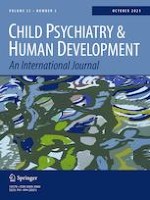22-09-2020 | Original Article
The Mediational Effect of Affect Dysregulation on the Association Between Attachment to Parents and Oppositional Defiant Disorder Symptoms in Adolescents
Gepubliceerd in: Child Psychiatry & Human Development | Uitgave 5/2021
Log in om toegang te krijgenAbstract
Oppositional defiant disorder (ODD) is a childhood disorder, commonly occurring in early school aged children with some symptoms becoming normative in adolescence (e.g., irritability, disagreeing). Affect dysregulation is a risk factor in the development of ODD. Affect regulation is nurtured within parent–child relationships, thus disruptions to attachment may derail children’s capacity to develop adaptive affect regulation, increasing the risk for ODD. Using a high-risk sample of adolescents, we investigated the association between attachment anxiety and attachment avoidance with ODD through affect dysregulation. Attachment anxiety, but not avoidance, was associated with affect dysregulation and ODD. Affect dysregulation was found to fully mediate the relationship between attachment anxiety and ODD concurrently and prospectively. Similar findings have been demonstrated among children; results show that attachment anxiety, and its effects on affect dysregulation, are associated with ODD symptoms well into adolescence.
